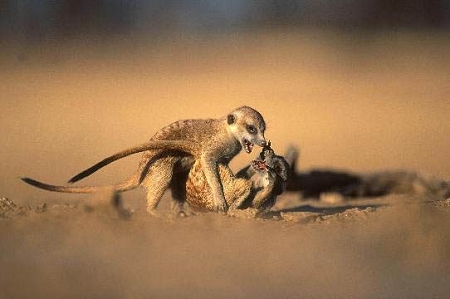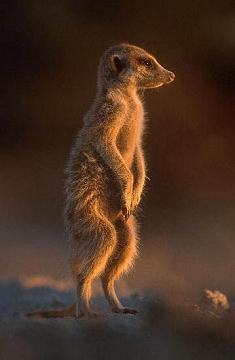African Photo Safari - Kalahari Meerkats
(with Nigel and Wendy Dennis)
At 8am on a May morning the Kalahari meerkats were having fun,
and so was I. Most of the family had completed their sunbathing
session. For the diminutive meerkats, regaining body heat after
a long cold night is an important priority. The youngsters began
the rough and tumble of a good play-fight, and were trying hard
to entice a few of the adults to participate as well. Lying flat
on the ground to take pictures at almost gecko's eye level, I
shot roll after roll whilst taking care not to get too much sand
into the camera. Probably this was the first time the meerkats
had seen a person lying on the ground and the youngsters were
puzzled by my odd behaviour. A couple of the braver ones - in
human terms they might have been teenagers - scurried up to me
to sniff my camera and press their noses right against the front
lens element to peer inside.

For a photographer such accommodating subjects offer a rare opportunity.
As a rule, a person on foot would be fortunate to get within a
hundred meters before these normally shy skittish creatures bolt
in terror. The meerkats I was photographing were truly wild, but
had lost their natural fear of humans. They regard a person in
much the same way as a springbok or wildebeest - just another
large animal that hardly warrants a second glance as it is totally
harmless. Getting wild animals to lose their fear of humans is
not achieved easily - the painstaking process of habituation takes
several months of patient work. I was very fortunate indeed that
someone else had done all this hard work for me. These meerkats
had been studied intensively by a research team funded by Cambridge
University. Each day over a period of several years the researchers
had followed the meerkats on foot to study their behaviour, probably
making this group the most approachable in the entire Kalahari.

Being regular visitors to the Kgalagadi Transfrontier Park (formally
known as the Kalahari Gemsbok National Park) Wendy and I already
had hundreds of meerkat images in our files. However this time
we had returned to gather additional material for a book assignment
just on meerkats. Making a book on a single species is a tricky
task. Even with a subject possessing such an abundance of character,
it is all too easy for a book to look repetitive. My intention
was to add variety by utilising a wide range of equipment - everything
from a ultra wide angle 20mm lens to the 600mm super telephoto
was pressed into service. Equally important, to make the book
interesting I needed to record a good diversity of behaviour.
Taking pictures of a meerkats sunbathing outside their burrow
is ridiculously easy - they just line up for a family portrait.
Once they begin foraging it is a different story. Being such tiny
creatures, meerkats exist in a more rapid time scale than us humans
are accustomed to. Beetles, geckos and grubs are unearthed and
consumed in a second. Even venomous scorpions are disarmed and
wolfed down with incredible speed. I found unless I got onto the
action instantly it was all over before I could even press the
shutter button. I pretty much had to resort to firing long bursts
with the motor-drive set at high speed and hope the auto-focus
tracking kicked in. I generally do not favour 'machine gun' tactics,
but there was no alternative with these fleet little super predators.
 Meerkats
are under the constant threat of predation during every moment
of the day. For this reason the adults take turns at sentry duty.
Martial eagles and jackals are particularly feared. Immediately
upon hearing a warning call from the sentry the entire group will
flee to the nearest bolt hole. For a photographer crawling on
the ground after meerkats, the Kalahari presents other dangers.
Lion are unlikely to be spotted until it is too late, and aggressive
Cape cobras are everywhere. We also had to take turns as sentry
from the roof of our vehicle - in fact it was a condition of our
official photographic permit that somebody would always be on
the lookout if one of us left the vehicle. Since I was doing the
assignment, Wendy unfortunately got the raw end of the deal and
acted as lookout for hours on end. At times though, I would sense
growing a impatience emanating from the car roof, so we would
swap roles for a while - just as if she were a meerkat that had
been left on sentry duty for too long!
Meerkats
are under the constant threat of predation during every moment
of the day. For this reason the adults take turns at sentry duty.
Martial eagles and jackals are particularly feared. Immediately
upon hearing a warning call from the sentry the entire group will
flee to the nearest bolt hole. For a photographer crawling on
the ground after meerkats, the Kalahari presents other dangers.
Lion are unlikely to be spotted until it is too late, and aggressive
Cape cobras are everywhere. We also had to take turns as sentry
from the roof of our vehicle - in fact it was a condition of our
official photographic permit that somebody would always be on
the lookout if one of us left the vehicle. Since I was doing the
assignment, Wendy unfortunately got the raw end of the deal and
acted as lookout for hours on end. At times though, I would sense
growing a impatience emanating from the car roof, so we would
swap roles for a while - just as if she were a meerkat that had
been left on sentry duty for too long!
|
|
Nigel's Photo Tip - Photo Assignments
|
For much of the time pro wildlife photographers work
on assignment, such as the meerkat book project described
in this article. I like assignments for two reasons. Firstly
they put bread on the table, but equally important an
assignment makes me put more effort into producing a good
variety and depth of coverage on a subject. I usually
finish up getting far more interesting pictures than if
I had been snapping away without any particular purpose
or direction. If you are a photo enthusiast (I don't like
the rather derogatory term 'amateur', as many 'amateurs'
produce work of excellent quality but choose - perhaps
very wisely - not to try to make a living out of photography)
then setting your own assignment is an excellent idea.
Pick an area you can visit regularly - even a tiny nature
reserve in an urban area can have lots of potential. Aim
to record as much as possible - animals, birds, reptiles,
flora, trees, scenics - everything in fact. The chances
are you will be photographing many subjects you have not
attempted before, and are sure to learn lots of new skills
along the way. Also plan to have an audience for your
work, such as making a slide presentation at your local
Wildlife Society or Bird Club meeting.
|
About the Author: Born in England
in 1953, Nigel Dennis developed a deep interest in the natural
world from an early age. First finding expression in the form
of painting nature subjects, he also became interested in photography
just over twenty years ago. Living in England at the time, his
first projects included photographing red deer and the shy nocturnal
European badger. For the badger photography he spent over forty
nights photographing whilst still managing to hold down a busy
day job. Nature photography soon overtook painting as a means
of expressing his passion for the natural world and from the early
eighties his work began to be published in books and magazines.
He moved to Africa in 1985 with a view to
making wildlife photography a full time profession. During his
first few years in Africa he continued with his previous career
in sales and marketing, but still spent about one hundred days
a year photographing by utilising all his annual holidays and
weekends. Eventually having built up a sufficient stock of wildlife
images he launched into the rather precarious occupation of freelance
wildlife photographer in 1991. Since then he and his wife Wendy
camp in the African bush for up to nine months each year. Although
they work mainly in South Africa they also photograph regularly
in Namibia and have visited Botswana, Zimbabwe, Zambia and Madagascar.
Nigel Dennis photographs all natural subjects
including reptiles, insects, flora and landscapes but tends to
concentrate primarily on African animals and birds. His work is
marketed by fifteen stock photo agencies and has been published
world-wide in over twenty five countries. He also runs his own
photo library supplying images to the publishing and advertising
industries, and currently has over 40,000 transparencies on file.
He does not take on commercial or advertising assignments and
works primarily on book and magazine projects. Nigel Dennis has
had twelve wildlife coffee table books published to date.
You can see more of Nigel's work at the following websites:
Profotos
- Nigel Dennis
Nigeldennis.com










